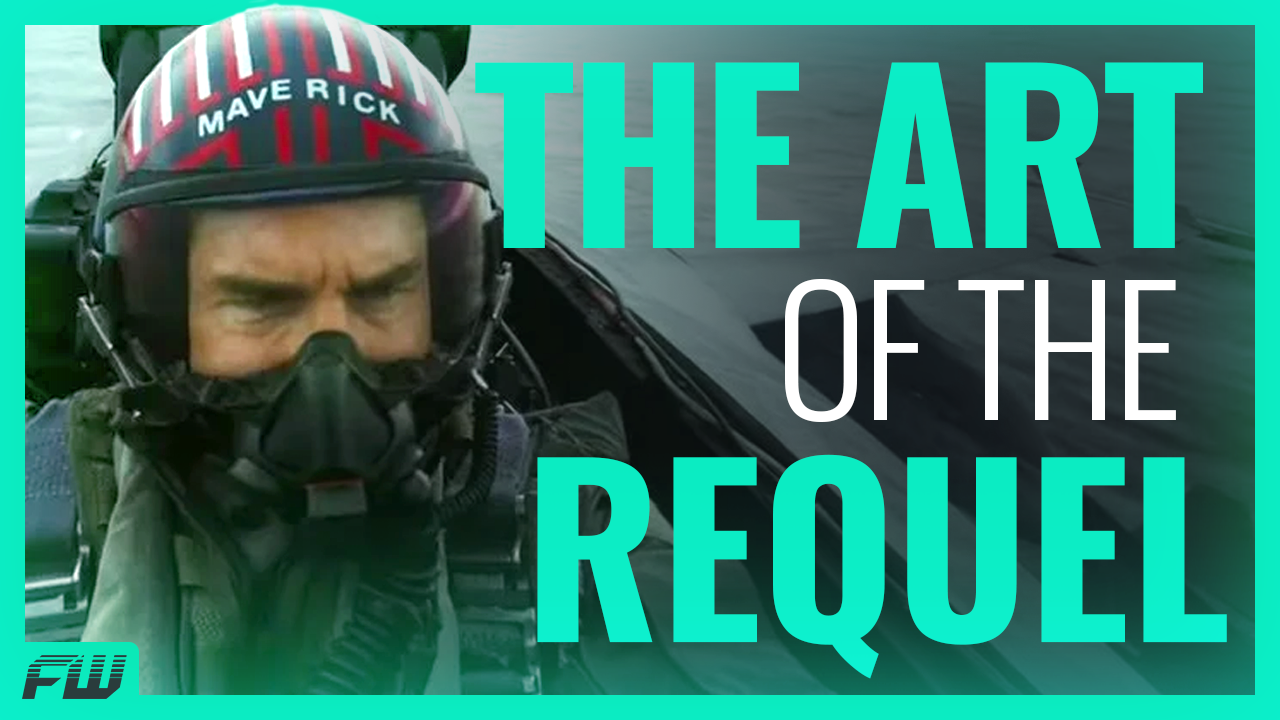FandomWire‘s latest Video Essay explains how to make a great requel movie.
Check out the video below:
Subscribe & hit the Notification Bell so you never miss a video!
The Art of the Requel
Much to everyone’s surprise — well, except maybe Tom Cruise’s — Top Gun: Maverick has become the smash hit of the summer, becoming the highest-grossing film of the year so far, out-grossing the likes of The Batman and Doctor Strange in the Multiverse of Madness. So how did a sequel to a film that came out nearly forty years ago become the movie event of 2022?
The answer is simple: it is perhaps the perfect requel.
What is a requel, you ask? As defined by Jasmin Savoy Brown’s Mindy Meeks-Martin in the 2022 film Scream, a requel is not quite a reboot but not quite a sequel. A requel introduces new main characters and partners them with the characters we all know and love from the original franchise. It has a standalone story of its own but also continues the overall franchise arc.
Following this formula pushed the 2022 Scream to success. The film made $81 million at the domestic box office and earned a 76 percent critics score and 81 percent audience score on Rotten Tomatoes. It was the first theatrical event horror movie since the reopening of movie theaters after the COVID-19 shutdown.
All the signs were there that Top Gun: Maverick was going to overperform, but no one expected it to be the massive hit it has become. When critics and audiences found out that the movie was great, giving it 97 percent and 99 percent on Rotten Tomatoes, respectively, we knew that it would get some good word of mouth, but for it to have made over $600 million domestically is insane.
Or is it?
Rewind seven years, and you will see the beginnings of this requel trend and see several films have massive success. In June 2015, Jurassic World made $653 million and was received mostly warmly by critics and audiences. But this was before anyone really knew what a requel was, so the concept still felt fresh.
That November, we would see a requel to the iconic sports movie Rocky in the form of Creed. Ryan Coogler’s film would follow the son of Apollo Creed, one of Rocky’s former opponents, as he is mentored to become a fighter by Stallone’s Rocky himself. It was both a critical and a commercial hit, earning $108 million domestically and earning Stallone an Academy Award nomination for reprising his role.
However, the film that would really kick off the trend came out that same December: Star Wars: The Force Awakens. Still the highest-grossing movie of all time domestically, The Force Awakens was a continuation of a franchise that everyone loved but introduced new characters that would come to be embraced by the fandom.
This film struck the perfect balance of nostalgia and modernization, taking a story that is not too dissimilar from the original story of A New Hope but infusing it with new heroes to make it feel just different enough not to be an outright remake. It’s comfortingly familiar and yet took the series in exciting new directions.
Yet the requel didn’t actually start in 2015. In fact, it’s almost fitting that Scream popularized the term requel because it was the horror genre that gave birth to this idea of bringing back the original characters and partnering them with “new blood” to create a unique take on the horror sequel.
Elements of the requel can be seen in Wes Craven’s New Nightmare, which was released all the way back in 1994. A film that also revolutionized the idea of meta filmmaking, it featured the return of Heather Langenkamp as both herself and her character from the original movie, Nancy Thompson, as well as a few other familiar faces from the franchise.
After a series of sequels that were inconsistent in quality but generally considered by Craven to be too “cartoonish,” New Nightmare was considered the “reset” to the franchise. It brought the franchise back to its “more cerebral” roots while taking it in a radical new direction. (The next entry in the Elm Street series would be Freddy vs. Jason, another radical departure.)
And yet, New Nightmare was the lowest-grossing Elm Street movie in the franchise. Maybe audiences just weren’t ready for the radical blend of meta-commentary and familiar characters. The film was well-received by critics, getting a 78 percent on Rotten Tomatoes, but that did not translate into commercial success.
However, a mere four years later would come the first commercially viable requel: Halloween H20: 20 Years Later. Bringing back Jamie Lee Curtis as Laurie Strode, the film retconned the generally maligned sequels that had come before and continued Laurie’s story. The film made $55 million domestically on a $17 million budget.
So what was it that made Halloween H20 successful and not New Nightmare? After all, both are among the most acclaimed slasher franchises of all time. Ultimately, it boils down to the fact that New Nightmare was arguably a bit too different for its own good. Had New Nightmare come out today, it probably would have been a raging success.
This fact is evidenced by the relative lack of success that Scream 4 had when it came out in 2011. Craven explores many of the same themes in Scream 4 that would eventually be redone in 2022’s Scream, but the film only made $38 million domestically. There has since been a fan and critical reevaluation of the film, saying it was slept on when it was released, but audiences weren’t ready for it at the time.
Indeed, if it was Jurassic World, Creed, and The Force Awakens that made legacy sequels viable commercially, it was the 2018 Halloween that made every retro franchise want to hop onto the retro train. Franchises like Jurassic Park, Rocky, and Star Wars were already huge money-makers, but the massive success of Halloween is what caused Hollywood to take a chance on more “obscure” franchises.
Halloween is obviously a beloved film, but all of its sequels are… not so much. But the fact that the film could make $159 million domestically on a $10 million budget made Hollywood want to cash in on this trend. Still, they learned the wrong lesson from that film’s financial success. Audiences didn’t want a sequel to just anything, especially if the filmmakers were going to take it in a radical new direction.
Denis Villeneuve’s Blade Runner 2049 was beloved by critics, and it is an unquestionably great film, but it wasn’t much of a money-maker at the box office. Why is that?
The truth is audiences weren’t looking for a requel to a cerebral sci-fi film that they don’t really understand but respect because of its vision. Sure, fans loved to see Harrison Ford back in his role as the maybe-replicant Rick Deckard, but the film only made $92 million at the US box office despite a massive budget.
The same issue plagued The Matrix Resurrections. People love the original Matrix, but the truth is that most general audiences liked the action elements more than the cerebral sci-fi ones. And for this film, while there is still some action, Lana Wachowski doubled down on the cerebral aspects.
Both are great films, and they found their audience of fans, but they didn’t break out to the same level of commercial success as The Force Awakens or even Halloween. And the reason is that they did not focus on what general audiences loved about the original film. They catered to their niche of fans and had a niche-driven box office response as a result.
So that brings us back to Top Gun: Maverick, which is poised to become the most successful requel since The Force Awakens. Is it lighting in a bottle? Perhaps. But it does follow a formula with elements taken from the other successful requels of the past.
Like The Force Awakens, Top Gun: Maverick follows a similar overall structure to the original. For the first hour or so of the film, they are going on a series of high-octane training exercises, culminating in a third-act mission that uses everything they were taught in an explosive, action-packed finale.
If you map out the film beat-by-beat with the original, you can see where there are parallels between the arcs of Maverick and crew in the original and Rooster and crew in the sequel.
But what is the distinguishing factor that makes Top Gun: Maverick work so well as a requel and not just a remake? Raised. Stakes.
There is no denying that the finale of Top Gun: Maverick is maybe one of the most epic action sequences ever committed to film. Filmmaker Joseph Kosinski and his team created a new way to shoot all of the aerial sequences in the film, resulting in action that feels even more cinematic than the original.
What Tony Scott did in the original film was fantastic for the technology he had at his disposal at the time, but comparing it to what Kosinski did in Top Gun: Maverick is like night and day. Everything is so much bigger, and that is precisely what audiences want to see.
We would also be remiss if we didn’t acknowledge the circumstances in which the film came out. The COVID-19 pandemic resulted in a long time when big movies weren’t coming out to theaters as often, and Top Gun: Maverick is one of the first films that absolutely demanded to be seen on the biggest screen possible. Although the beauty of Blade Runner 2049 certainly warranted a theatrical viewing, it didn’t benefit from the same pent-up demand.
But then there is also the matter of nostalgia. Several people grew up on Top Gun. Some saw it in theaters as kids and were inspired to join the military. Then, they showed it to their kids. It’s a movie with appeal across age groups, which is a critical factor in its success.
The Force Awakens works because people have been sharing Star Wars with the next generation for as long as the franchise has existed. 2018’s Halloween worked because the original film is one of the first horror movies many kids see since it has such a stronghold on the genre. Top Gun: Maverick works because Top Gun is a cultural sensation, and there really is nothing like it.
Many franchises have tried and failed to make requels. And with the success of Top Gun: Maverick, many more will likely attempt to follow in its footsteps. But the filmmakers wanting to capitalize on the popularity of these franchises must learn the right lesson. And it comes down to one simple concept: make a movie that EVERYONE will want to see.
What do you think? Why do you think Top Gun: Maverick has become so successful, and these other attempts at requels fell flat? Be sure to let us know in the comment section below, and don’t forget to like and subscribe. And if you like the work FandomWire is doing, be sure to visit our affiliate link at Humble, where you can purchase and play games for a great, low price while supporting us and allowing us to make more quality content like this. Until next time, thanks for watching.
Follow us for more entertainment coverage on Facebook, Twitter, Instagram, and YouTube.


